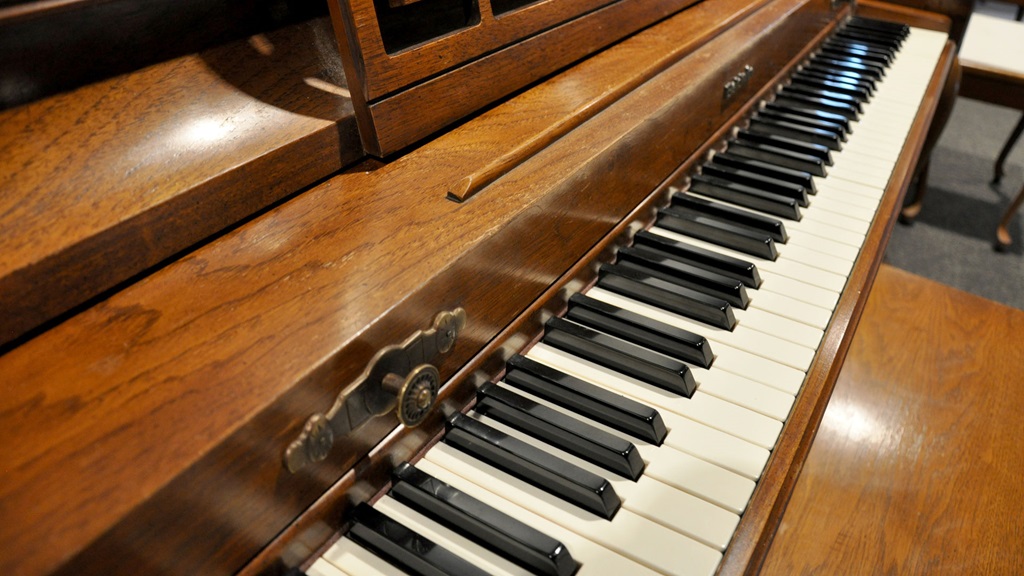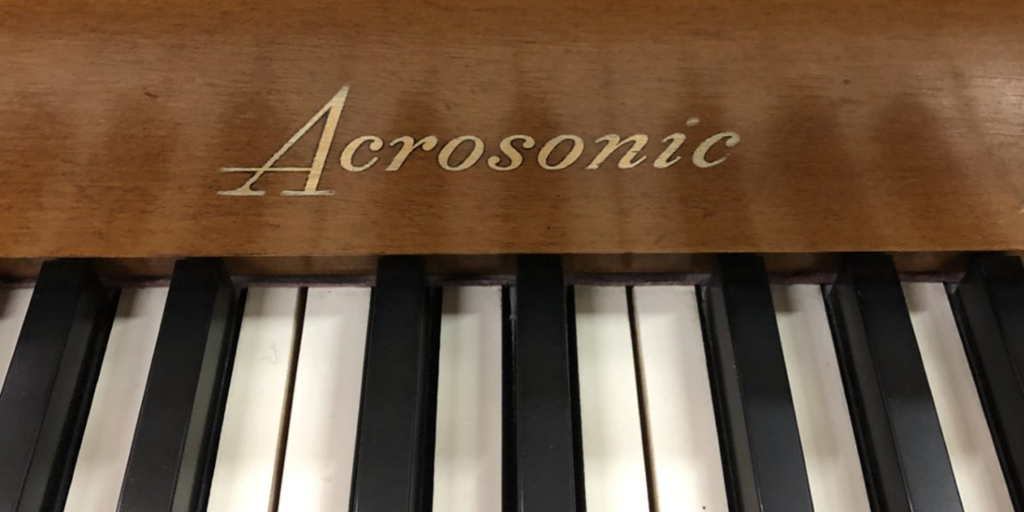If you’ve browsed your local online marketplace for used pianos before, chances are you’ve come across listings for “Baldwin Acrosonic” models. With their mid-century design and reputation as a budget brand, these vertical pianos tend to be very affordably priced compared to other vintage instruments. But are Acrosonic pianos actually any good for aspiring musicians on a budget? Or are buyers better off saving up for a pricier used piano?
As an Acrosonic owner myself, I set out to uncover the history and qualities behind this product line to determine if these instruments live up to their intriguing, retro hype. Read on for a dive into all things Acrosonic, from their background and build to common repairs and ownership experiences.
The Origins of Baldwin’s “Air-Conditioned” Verticals
Before assessing the merits of Acrosonic pianos, it helps to understand the story behind the brand. Baldwin Keyboard Instruments traces its history back to 1862 Cincinnati, where namesake Dwight Hamilton Baldwin launched a small reed organ business. By the early 1900s the company rose to become the worlds largest producer of keyboards and operated the esteemed Hamilton piano line along with acclaimed Baldwin grand pianos.
Seeking an innovative, affordable vertical piano to appeal to working musicians and students, Baldwin unveiled the Acrosonic line in 1951. Company advertising touted their Civillico method of “Air Conditioning” via scientifically designed soundboards with 25,000 precision drilled holes. This construction aimed to allow unimpeded string vibration for optimal tonal projection in a compact vertical cabinet.
Early Acrosonic models sported mid-century flair with space age design elements like gold lettering, blond wood cabinets, and sleek tapered legs. By tailoring both the style and price point for postwar suburban households, Baldwin positioned the Acrosonic as their budget-friendly vertical piano suitable for school, church, and casual home use.
This branding proved successful over the following decades as Baldwin mass-produced Acrosonics alongside their Hamilton studio uprights. Common iterations include the standard 36-inch tall home models along with 44-inch and 48-inch console variations. While Hamilton pianos were made in America, most Acrosonics were manufactured in Korea or Japan between the 1960s through 1990s as production globalized.
Acrosonic Construction and Technical Specs

As a former 1960s example myself, I can attest Acrosonic pianos feature an attractive, easily maintained style while offering an acceptable base performance for hobby play. But let’s analyze the build and components to reveal where corners were cut to meet entry-level pricing.
Cabinet Construction
Most vintage Acrosonics utilize laminated wood soundboards often with particle board backing, a step down from the solid spruce soundboards found in professional models. The wooden action rails that hold the mechanical hammers and keys also tend to be basic plywood rather than higher-density hardwoods. Without sufficient density, these key components sound dull quicker than old-growth solid wood.
However, Acrosonics often came stock with nice cosmetic details like contrasting inlays along curved vertical panels. The streamlined tapered leg design helped maximize floor space pre-electronics when pianos dominated household interiors. Durable paint or lacquer finishes have helped many Acrosonics retain their retrovisual flair 50+ years later.
Hammers & Key Action
Rather than costly wool felt, most Acrosonics utilized firm but lightweight synthetic felt for their hammers. Combined with basic nylon action parts, this results in a lighter key press than a true performance piano. For casual hobbyists this can ease playability for those lacking finger strength. But for accomplished pianists desiring dynamic touch and expression, the action can leave much to be desired.
The keys themselves were historically smaller than standard concert grand pianos at .28 meters versus .30. At just 36 notes, the short keyboard and upright design clearly cater towards space efficiency over catering towards advanced classical pieces written for 88 keys.
Hardware & Strings
Rounding out an Acrosonic piano build, hardware elements tend towards serviceable baseline quality. Most cabinets came equipped with canned spool tuning pins, decent lengths of music wire, and generic metal chasing pins and agraffes with a propensity to rust if humidity wasn’t regulated.
The pragmatic design extended to cost-driven corners like laminated bridges prone to cracking versus solid alternatives. Felt and cloth interior insulation also deteriorates quicker than performance grade materials when subjected to changing humidity and direct wall contact.
Performance & Tonal Characteristics
Keeping their economical production and components in mind, most Acrosonics deliver fair but unexceptional performance capabilities. Their compact vertical cabinets project sound forwards without the rich resonance of grand pianos. Notes showcase good fundamentals with clear attack and brightness. Yet the tone lacks fullness, depth, and color compared to Baldwins prestigious Hamilton models.
With their condensed upright design, Acrosonics also fall short when asked to fill larger spaces or compete against louder instruments. What they do offer for small rooms is engaging playability thanks to responsive actions with low friction synthetic parts. For kids progressing through method books or casual hobby play, most Acrosonics offer a cost-effective way to learn piano with serviceable tone.
Common Acrosonic Repairs and Ownership Considerations
Given their production era and budget status, Acrosonic pianos frequently show aging elements decades later. But well-maintained instruments can still make great starter pianos after addressing common wear issues. Lets explore what to expect under the lid and how to spot red flags:
Checking Action, Strings & Tuning Stability
Since vertical pianos withstand decades of hard play by kids, the hammer felts often wear to leave grooved strike points. Combined with loose key actions, this impedes dynamic control and tones the piano well below peak form. Heavy tunings also loosen and wear tuning pins causing slippery strings.
Inspecting bridges, soundboards, pinblocks will reveal further cracks signaling the integrity is beyond repair. However its common to revive playability with new hammers, key bushings, restringing, voicing, and tuning stability upgrades. Just ensure the harp and bridges have lifetimes left before investing in major work.
Condition of Cabinets, Legs & Hardware
While worn sound production elements hide out of sight, inspecting an Acrosonics visible exterior paint, panels, handles, and legs reveals further clues of its care or neglect. Minor scuffs add vintage character, but structural damage, detached veneers, missing pedals, and rust warrant deeper inspection at minimum. If humidity or direct ground contact caused swelling lower panels, further unseen deterioration is likely.
Any major cabinet damage or extensive restoration needs can easily outweigh potential value. But refinishing and rehanging loose tuning pins often restore both functionality and eye-catching style at a fraction of buying another piano. Take the cost of desired updates into account when negotiating price.
Weighing Repair Investments
Despite their quirky charm, restoring the plywood construction and laminate elements of most Acrosonics to professional standards costs more than their actual resale value. The question becomes what condition and investment makes sense for your skill level. As starter instruments, revived Acrosonics still offer ample value and playability to learn on before upgrading down the road.
Targeting models with decent bones that just need basic maintenance and cosmetic care is often the savviest route. Sourcing replacement parts for mid-century off-brand pianos also proves far simpler today thanks to global supply chains. This opens DIY repair opportunities impossible decades ago.
Properly Caring for Your Acrosonic at Home
Should you add an Acrosonic to your family’s musical journey or collection, be sure to care for its sensitive wooden interior by:
- Placing felt pad floor protectors beneath legs away from air vents
- Investing in a quality humidity control system
- Keeping closed when not playing to slow finish fading
- Closing the key cover to avoid objects or dust damaging action
- Scheduling annual tunings to stabilize and preserve strings
Remember that initial tuning expenses after moving to properly acclimate the instrument also proves vital before enlisting eager new players. Taking measures to regulate humidity and temperature changes will extend any pianos lifespan exponentially.
Weighing the Acrosonic Value Proposition

Given their ubiquitous classifieds presence at bargain prices, its natural to wonder if Acrosonics offer hidden gem potential or just sound too good to be true. By learning their background and performance traits, its clear these pianos entice based more on nostalgic appearance than actual musical prowess.
However, restored and maintained Acrosonics can still deliver enjoyable playing experiences as starter instruments. And investing in sufficient repairs grants years of family use before upgrading. Just refrain from overextending on initial purchase prices or restoration efforts beyond their actual resale value.
For small spaces on strict budgets, passed down Acrosonics often prove “good enough” to spark an enduring love of play without breaking the bank. But accomplish pianists and those with larger spaces will want to consider saving up for used Baldwins, Yamahas, Kawais or other professional uprights and baby grands to truly unlock expressive potential.
When dealing with entry-level brands, carefully inspecting individual condition and factoring in maintenance costs remains vital. By setting realistic sonic expectations, Acrosonics offer a cost-effective way to add vintage flair and musical enjoyment to your home when scored at the right price point.
Just ensure you have an expert technician assess repair needs before playing to catch issues early. Addressing minor touch-ups right away keeps your investment sounding its best for years to come.
In Conclusion
While Acrosonic pianos fail to match the construction quality or capabilities found in Baldwins flagship Hamilton models, their charming mid-century style and playability still prove endearing today. When purchased at fair used prices and properly maintained, most Acrosonics offer enjoyable musical experiences accessible to households lacking elite instrument budgets.
However, prospective owners need to inspect aging conditions closely and invest wisely into necessary updates for ideal playability and longevity. Overall if sourced carefully as starter pianos, Acrosonics can jumpstart many families and budding musicians musical journeys for years to come.
FAQs
How much do vintage Acrosonic pianos cost?
Acrosonics typically sell between $200 – $800 depending on age, condition, and ownerrestored investments. Well-maintained mid-century examples with minimal wear often list around $600.
What is the average lifespan of an Acrosonic Piano?
With periodic maintenance like tuning, hammer conditioning, and timely repairs, Acrosonics often play well for 50-60 years. Installing humidity control extends their prime playing abilities even longer before deterioration impacts tone.
Should I restore an old Acrosonic piano myself?
While repainting cabinets proves straightforward for DIYers, attempting internal sound production restoration with no training risks further damage. Consult technicians to determine sensible update costs before taking on specialized repairs yourself.
How much do Acrosonic piano restorations or repairs cost?
Basic tunings run around $125 and full restringing costs $750+ for Acrosonics. Soundboard patching or bridge repairs can range $400-$1,000+. Weigh investing 10-30% an Acrosonic’s value before restoration expenses outweigh finding a cleaner instrument.
Are Acrosonic pianos good for beginners learning piano?
Yes, Acrosonics work wonderfully for beginning hobby piano thanks to compact sizes and keys offering light, responsive actions. Ensure worn hammers and loose tunings stabilization are addressed before extended play to aid student development.





